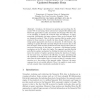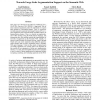ASWC
2008
Springer
14 years 1 months ago
2008
Springer
Abstract. Nowadays, the demand on querying and searching the Semantic Web is increasing. Some systems have adopted IR (Information Retrieval) approaches to index and search the Sem...
FLAIRS
2007
14 years 1 months ago
2007
Web search engines like Google have made us all smarter by providing ready access to the world's knowledge whenever we need to look up a fact, learn about a topic or evaluate...
AAAI
2007
14 years 1 months ago
2007
Ontology mapping is a complex and necessary task for many Semantic Web (SW) applications. The perspective users are faced with a number of challenges including the difficulties o...
AAAI
2008
14 years 1 months ago
2008
The Semantic Web language RDF was designed to unambiguously define and use ontologies to encode data and knowledge on the Web. Many people find it difficult, however, to write com...
AAAI
2008
14 years 1 months ago
2008
One of the core goals of the Semantic Web is to store data in distributed locations, and use ontologies and reasoning to aggregate it. Social networking is a large movement on the...
AAAI
2007
14 years 1 months ago
2007
This paper lays theoretical and software foundations for a World Wide Argument Web (WWAW): a large-scale Web of inter-connected arguments posted by individuals to express their op...
ICALT
2009
IEEE
14 years 2 months ago
2009
IEEE
Nowadays, the Semantic Web technologies are exploited also in the e-learning domain in order to provide personalized and adaptive learning experiences, semantic annotation of lear...
ESWS
2010
Springer
14 years 2 months ago
2010
Springer
The Semantic Web movement has led to the publication of thousands of ontologies online. These ontologies present and mediate information and knowledge on the Semantic Web. Tools ex...
ESWS
2010
Springer
14 years 2 months ago
2010
Springer
Building and maintaining thesauri are complex and laborious tasks. PoolParty is a Thesaurus Management Tool (TMT) for the Semantic Web, which aims to support the creation and maint...
ICCS
2000
Springer
14 years 3 months ago
2000
Springer
With the aim of building a "Semantic Web", the content of the documents must be explicitly represented through metadata in order to enable contents-guided search. Our app...


